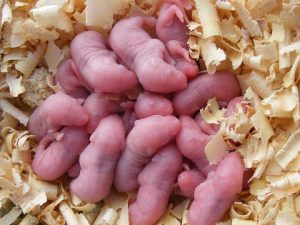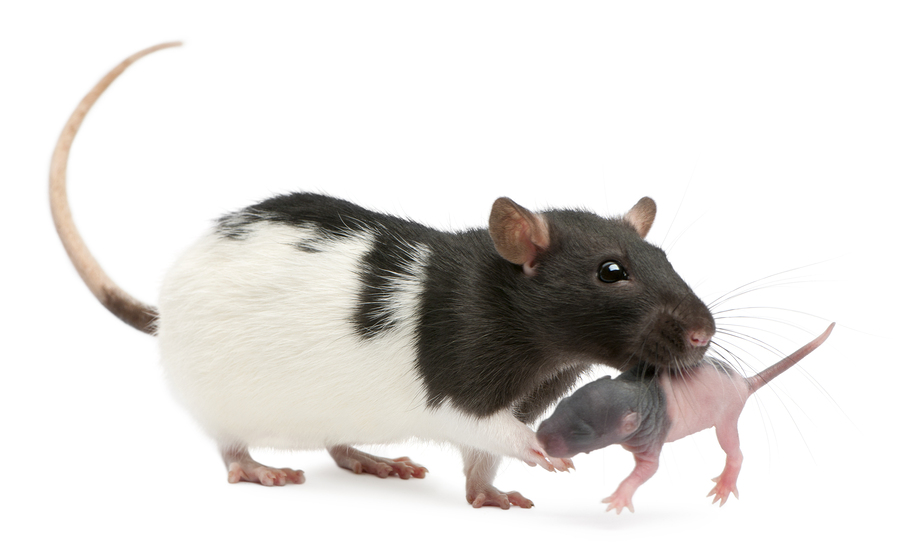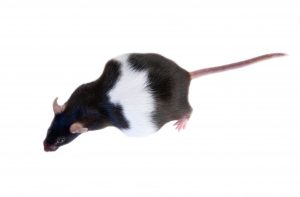

Cannibalism in Laboratory Rodents: Stressors to Avoid
A number of factors can influence the incidence of cannibalism in certain mammals. Species known to occasionally engage in cannibalistic behavior include pigs, rabbits, hedgehogs, hamsters, ground squirrels, and rats and mice. In the lab, certain strains of rats and mice are even more prone than others to eat their young. For example, C57BL/6 mice are known to regularly lose their first litter due to cannibalism and can routinely lose over 30% of their litters; BALB/c mice are a close second, commonly losing about 20% of their litters (1). This behavior is also seen in genetically engineered mice (GEM) (2), and can have disastrous consequences on the maintenance of those lines. In addition to the risk of completely losing highly valued and expensive mice, working with cannibalistic strains requires having to increase the number of cages and time needed to get an appropriate sized cohort ready for the experiments; thereby increasing the already high cost of those strains. Rats too can show cannibalistic tendencies, especially in older females (3, 4).
So, what can we expect in the lab? What species show cannibalism and for what reasons? In addition, what can we do to decrease this behavior and support the health and welfare of our breeders and pups? Indeed, many factors influence cannibalistic behavior (5). Let us review a few.
Cage & Cleaning Frequency
Recently, it has been shown that the type of caging used in the animal room can have an effect on breeding performance, especially in GEM strains, which might require special care and housing. While two main caging types are used to limit the risk of spreading unwanted microorganisms, Individually Ventilated Cages (IVC) and Static Micro Isolator Cages (SMIC), SMIC filters can interfere with ventilation, and cause the accumulation of carbon dioxide and ammonia, subsequently leading to a decrease in pup survival (6).
Additionally, the frequency of cage cleaning can also affect reproductive productivity: frequent cage-cleaning, defined as twice weekly, significantly increased cannibalistic behavior in rats. Indeed, with more frequent cage cleaning, pups were more likely to be exposed to this event that disrupts the nest and scent marks, and were consequently more likely to be cannibalized (7).
TIPS: To avoid inducing cannibalism, it is recommended to avoid any disturbances during late pregnancy and the first few days after birth. If cleaning is necessary, picking up the litter gently, together with dirty bedding and nesting material will help to transfer scents (8).
Environmental Disturbances & Stress
Mice and rats are very sensitive to lights and sounds. In lab settings, animal rooms typically have a 12hour dark/light cycle. However, sounds are much less controllable. Computer, wheel carts, technicians activities can not be eliminated, but can be covered with background music. Sudden and loud noises and rough cage handling can increase the risk of mis-mothering or cannibalism, and should be avoided (9).
“There’s quite a bit of construction going on around our facility, so breeding complications and fighting have increased. Many researchers have reported success including DietGel® Prenatal into their protocols. ” says R. Malbrue, Clinical Veterinarian at Nationwide Children’s Hospital
REQUEST YOUR SAMPLE OF DIETGEL® PRENATAL NOW!
TIPS: Not all stressors can be avoided. To counter-balance their effects, providing environmental enrichment to reduce stress and keep the mothers busy can help decrease the rate of cannibalism. Nesting material and nest building for example have be shown to play a crucial role in pup survival (10, 11, 12), while reduced temperature inducing cold stress have been shown to increase cannibalism (13). Therefore, providing hut/house, tissue paper, nestlets or extra bedding can significantly reduce pup mortality, both by keeping the mom and pups warm, and reducing the breeders’ stress level.
Undernutrition
Interestingly, the COVID-19 pandemic has had unexpected consequences on the rat population: as many restaurants and grocery stores closed their doors last year, and people sheltered indoors, rat colonies long established in the proximity found themselves suddenly cut off from their primary source of food. They took over the streets, battled each others and resigned to infanticide and cannibalism – a behavior reported in both the USA (14) and UK (15). This is not a unique situation: mice resorted to cannibalism in South Australia after a culmination in weather conditions in 2018 (16), hamsters in France also engaged in infanticide after the region was taken over by the industrial farming of corn in 2017 (17), and closer to us here in Maine, squirrels, although not resorting to cannibalism, took much riskier behavior when the population boomed in 2018 after very abundant acorn crops the previous year (18).
This is all part of natural selection and self-regulation of populations: shortage of food, inadequate diet and undernutrition or malnutrition can produce altered behaviors. Lactational demands will intensify the deficiency, and when resources are limited, females may reduce litter size through infanticide (19). In other species, lack of specific nutrients including protein and vitamin B3, or nutrient imbalance have been shown to result in cannibalism.
For more on cannibalism, read our previous blog
How to Reduce Cannibalism in Your Rodent Colonies
TIPS: Providing supplemental nutrition during pregnancy and lactation can support the females’ needs during those high demanding periods. ClearH2O DietGel® Prenatal contains 14.3 g of protein per 100g of gel and a full spectrum of vitamins and minerals, including 1 mg of Vitamin B3 (Niacin)per 100g of gel, supporting the females’ needs after birth. DietGel® Prenatal also contains flax seeds, giving the females the opportunity to forage through the gel and reduce her stress.
A study from Indiana University with DBA/2 mice showed that providing DietGel® 76A to breeder cages reduced cannibalism by about half. In parallel, a study from Tufts University on C57BL/6 mice showed that adding DietGel® 76A to breeder cages increased pups survival to weaning age by about 40%
REQUEST YOUR SAMPLE OF DietGel® 76A or DietGel® Prenatal NOW!
Abnormal Offspring
Malformed, abnormal, defective and nonviable offspring are also selectively cannibalized by the dams (20). It is hypothesized that the dam has some discriminatory ability in identifying such offspring through her senses (tactile, visual, olfactory). When newborns need to be manipulated, either to assign them a number, genotype them, or for experimental reasons, the problem arise: hard and meticulous work is needed to proceed with a successful surgery, only to have the pup rejected or cannibalized by the dam (21)!
TIPS: Some conditioning of the pregnant females before delivery, including hand gentling and olfactory conditioning of pregnant females, can lead to successful reintroduction of the pups after surgery without cannibalism or rejection from the dams (22). As for methods of identification of the pups, reports on C57Bl/6 mice indicated that toe clipping and tattooing newborn mice (dorsal skin, toe or tail) did not lead to rejection, mortality or cannibalism (23).
For more on cannibalism and other breeding challenges and tips for improved breeding success:
Download our Breeding Guide!
References:
(1) Influence of Strain and Parity on the Risk of Litter Loss in Laboratory Mice – Weber, 2013 (PMID: 22809230)
(2) Use of perphenazine to control cannibalism in DBA/1 mice – Carter, 2002 (PMID: 12405639)
(3) Age-dependent cannibalism in a colony of albino rats – Mohan., 1974 (PMID: 4855742)
(4) The mother-litter relationship in developmental rat studies: Cannibalism vs caring – DeSantis, 1984 (PMID: 6539261)
(5) Cannibalism in Rats and Mice – Lane-Petter, 1968 (PMID: 5727015)
(6) Reproductive performance of genetically engineered mice housed in different housing systems – Yadav, 2017 (PMID: 28747970)
(7) Effects of cage-cleaning frequency on laboratory rat reproduction, cannibalism, and welfare – Burn, 2008 (PMID: 4226758)
(8) Effects of Age of Pups and Removal of Existing Litter on Pup Survival during Cross-Fostering between Multiparous Outbred Mice – Hickman, 2011 (PMID: 22330709)
(9) Mice Housing and Husbandry – NC3Rs
(10) Effects of enrichment devices on stress-related problems in mouse breeding – Inglis, 2004
(11) Do Laboratory Mouse Females that Lose Their Litters Behave Differently around Parturition? – Weber, 2016 (PMID: 27575720)
(12) Environmental enrichment prevents pup mortality in laboratory mice – Leidinger, 2019 (PMID: 29788793)
(13) Effect of cold stress on infanticide by female Swiss albino mice Mus musculus: a pilot study – Zafar, 2018 (PMID: 29713492)
(14) Starving, angry and cannibalistic: America’s rats are getting desperate amid coronavirus pandemic
(15) Summer of the cannibal rats! Hungry, aggressive, highly fertile – and coming to our homes
(16) Cannibal mice eat each other as grain harvest ends, lowering the rodent population
(17) Diets derived from maize monoculture cause maternal infanticides in the endangered European hamster due to a vitamin B3 deficiency – Tissier, 2016 (PMID: 28100816)
(18) Why Are There So Many Dead Squirrels On Maine Roads?
(19) Maternal behaviour in Mus musculus sp.: An ethological review
(20) Cannibalistic traits observed in rats treated with a teratogen – Shardein, 1978
(21) Neonatal rat surgery: avoiding maternal cannibalism – Libbin, 1979
(22) Improved techniques for successful neonatal rat surgery – Park, 1992 (PMID: 1460853)
(23) Identification methods in newborn C57BL/6 mice: a developmental and behavioural evaluation – Castelhano-Carlos, 2010 (PMID: 19854756)

